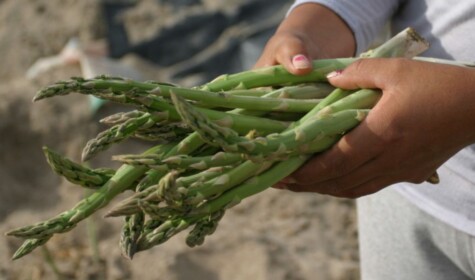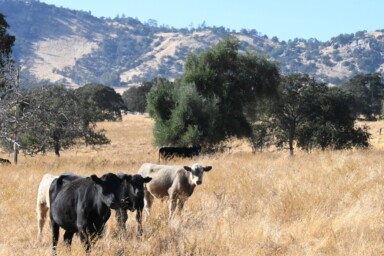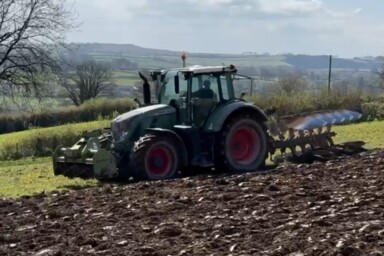What are you having for your Easter lunch? Roast lamb, leeks and new potatoes? Minted peas? The quintessentially English asparagus? Easter is synonymous with growth, new life, warmer weather and abundance. However, this picture can be deceptive.
For British farmers, spring is indeed a period for new growth, but little is ready to harvest. April is one of the leanest months in the farming calendar. The Hungry Gap, as it is called, lasts from March until June.
The reality for anyone trying to eat sustainably is that locally grown organic produce is scarce. British new potatoes may not be ready for Easter lunch. Neither will peas or spring onions. You may find broad beans and leeks. Of course you can get asparagus, but check the label – if it’s British the chances are it cost a fortune, if not it’s probably travelled 6000 miles.
Before I founded Crop Drop, a community-based organic veg box scheme – I was unaware of the hungry gap. When doing my grocery shop I would favour Union Jack labels, but a few food miles wouldn’t stop me from buying what I wanted. Now that I’m responsible for providing 90+ people each week with local produce, I pay more attention. Because of Crop Drop’s commitment to sustainability, I now know that this is a complex time of year requiring trade offs and sacrifices. Which means no asparagus. That quintessential spring treat is just too expensive for most of us!
Asparagus from Peru and Mexico can be found in supermarkets as early as February, costing around £2 per bunch. You will only find British asparagus from April to June, at more than twice the price. Until recently, Peru dominated the global market, devaluing British produce. But what’s the true cost of this South American success?
Apart from the obvious carbon footprint of all those air miles, lust for this luxury vegetable is creating a water crisis in Peru, leading to daily hardship, loss of livelihood and civil unrest. The UK charity, Progressio, investigated the crisis in 2010. What they found was alarming.
The Ica Valley in Peru is one of the driest places in the world. Thanks to major investment, mostly from the World Bank, large agri-businesses re-greened the desert in the 1990’s with monoculture fields of asparagus. According to Progressio, “cultivation of asparagus in Peru exploded to cover nearly 100 square kilometres by 2008.” They also reported that since the boom, “the water table in the valley has plummeted in places by as much as eight metres each year.”
 Ground water is provided by the Ica river, rising in the mountains of Huancavelica, Peru’s poorest region. Indigenous people, already lacked water because of mining pollution and depleted icecaps, which feed the river. Much of their supply is diverted to asparagus farms. In the Ica Valley, wells are drying up and water rates are astronomical, forcing farers to sell their land to the asparagus trade. Supplies are severely rationed, yet one giant asparagus farm can use as much water as the entire city of Ica every day.
Ground water is provided by the Ica river, rising in the mountains of Huancavelica, Peru’s poorest region. Indigenous people, already lacked water because of mining pollution and depleted icecaps, which feed the river. Much of their supply is diverted to asparagus farms. In the Ica Valley, wells are drying up and water rates are astronomical, forcing farers to sell their land to the asparagus trade. Supplies are severely rationed, yet one giant asparagus farm can use as much water as the entire city of Ica every day.
In 2002 alarm bells rang. Although irrigation technology has improved, there is still a dire need for government regulation of water supplies and corporate responsibility standards to be upheld by retailers.
Before you begin your boycott of Peruvian asparagus, consider that it has created near-zero unemployment in the region. However short-term and unsustainable, the asparagus trade has been a lifeline to the Peruvian economy. As the UK is the third largest importer, we have a responsibility to those livelihoods.
The price of asparagus doesn’t reflect reality. The costs of overexploiting precious resources are passed on to small farmers who cannot afford crippling water rates, to highlanders struggling to survive, and to all of us suffering the consequences of carbon emissions. So what should Peruvian asparagus really cost?
Our economic system forces us to decide between people and planet. It pits us against nature, treating ecosystems only as exploitable resources, and against each other, demanding low costs and cutting work forces in favour of mechanisation. However there is a growing clamour for a different approach to farming.
Vandana Shiva, director of the Navdanya movement, protecting small farms in India, says food production should transcend false measures which neo-liberal economics use to judge a commodity’s value. She claims that the economic, environmental and food crises all stem from outmoded paradigms rooted in the age of cheap oil and fossil fuels. We disregard ecological boundaries and focus solely on market value.
Closer to home, there’s a burgeoning movement quietly transforming food and farming in the UK. This includes farmers’ markets, food co-ops and community veg-box schemes. Growing Communities, a London-based social enterprise, has been running a veg-box scheme, an organic farmers’ market and “patchwork farms” – small growing sites nestled into the urban landscape – for almost 20 years. Julie Brown, the founder and director says, “we’re providing up to 3000 people with organic, seasonal and locally grown produce each week. We’re harnessing the collective buying power of the community, using it to change what we eat, how we eat and how it’s farmed.” They also have a start-up programme supporting more communities to set up their own veg-box schemes in the wake of this successful model.
These grass roots initiatives hold the key to a sustainable future. Which doesn’t necessarily help the people of Ica, caught between a rock and a hard place. Will this vital source of employment dry up, alongside the wells? What are Peru’s chances of developing sustainable systems? Since Progressio’s 2010 report, we have heard little about the situation. Until consumer awareness of asparagus production equals that of coffee, tea, cocoa, palm oil and sugar, there is no incentive for South American trade to implement Fairtrade initiatives or sustainability monitoring standards. Sadly, there is no clear solution yet. But let’s start with a reality check – this much loved Easter treat is a luxury item that Peruvians have paid a high price for us to eat.







